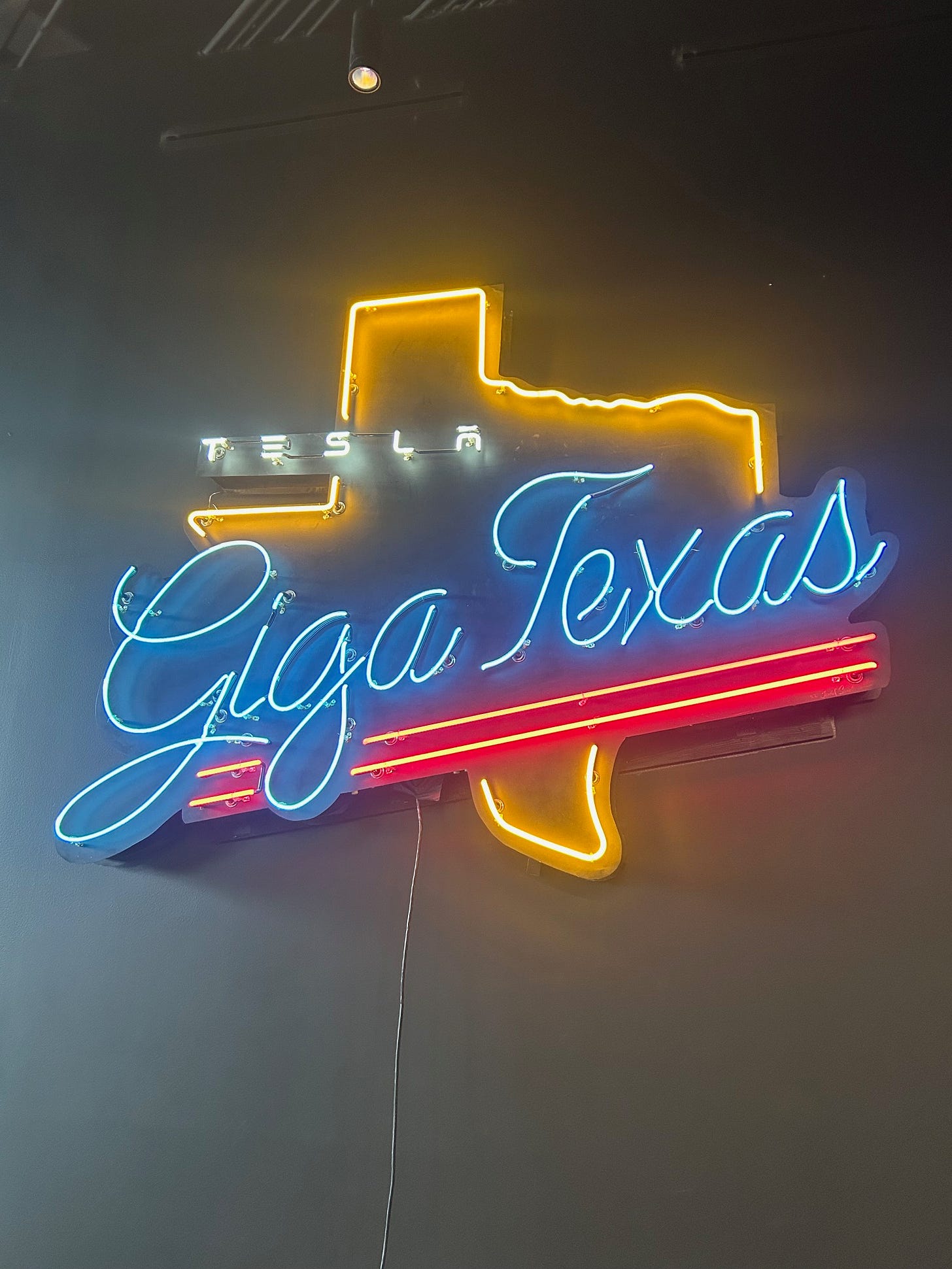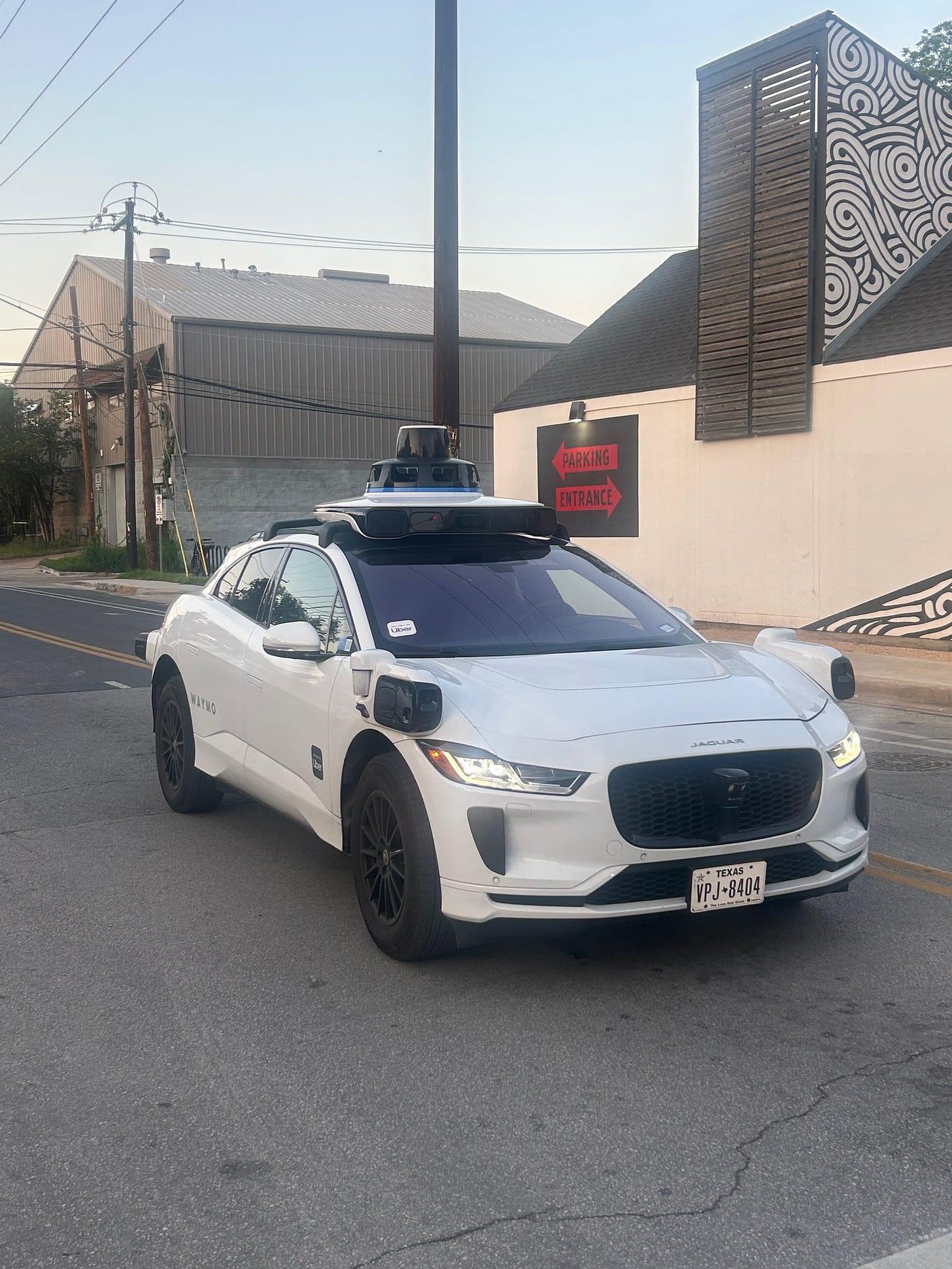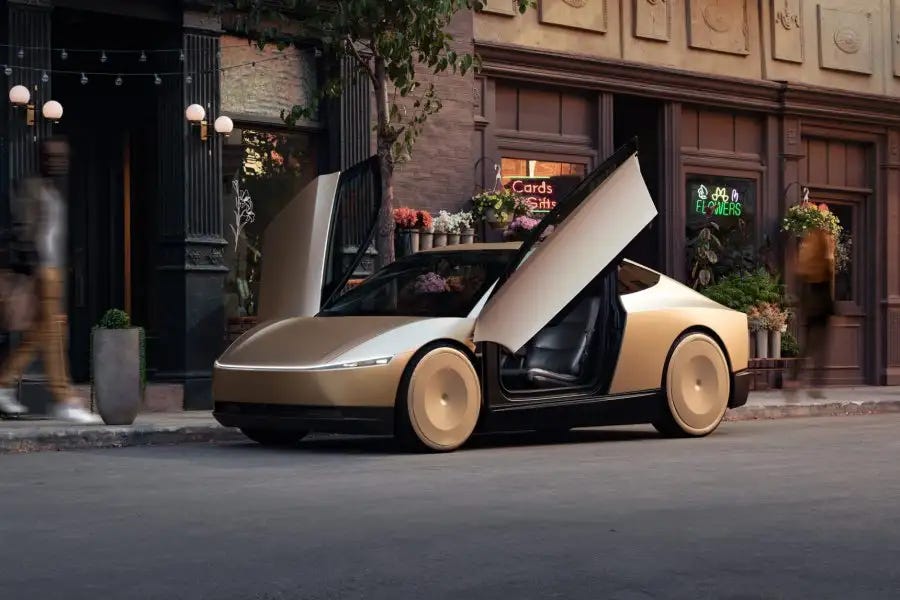Robotaxi Revolution: Why Tesla's Austin Launch Could Reshape Global Transportation
When Full Self-Driving Meets Network Effects
DISCLAIMER: This article is for informational purposes only and does not constitute investment advice. Investing carries significant risk, including the potential loss of principal.
This month Tesla is expected to launch its robotaxi service in Austin, Texas. For skeptics who have watched Elon Musk repeatedly push back autonomous driving timelines, this might seem like another overpromised milestone. But the data suggests something different is happening this time and the economic implications could dwarf anything Tesla has achieved with electric vehicles.
The global transportation market represents approximately $7 trillion annually. Today, private vehicle ownership consumes roughly $1.2 trillion of that total in the United States alone. Robotaxis don't just represent a new product category, they threaten to fundamentally restructure how humans move, creating the largest economic disruption since the internet.
To understand why Tesla's Austin launch matters, we need to examine the numbers behind autonomous transportation and why the company that solves this problem first could capture value that makes today's tech giants look small.
The Austin Advantage: Why This Launch Is Different
Austin wasn't chosen randomly for Tesla's robotaxi debut. The city offers several advantages that make it an ideal testing ground for autonomous vehicle deployment:
Regulatory Environment: Texas has some of the most permissive autonomous vehicle regulations in the United States. Unlike California, which requires extensive testing permits and safety driver requirements, Texas allows companies to deploy autonomous vehicles with minimal regulatory friction.
Geographic Characteristics: Austin's road infrastructure is relatively modern and well-mapped, with clear lane markings and standardized signage that make computer vision more reliable. The city's growth pattern means many roads were built with modern standards that autonomous systems can navigate more easily than older urban environments.
Market Size and Density: With a metropolitan population of 2.3 million and high ride-sharing adoption rates, Austin provides sufficient demand density to make robotaxi operations economically viable while remaining manageable for initial deployment.
Weather Conditions: Austin's climate avoids the extreme weather conditions that challenge autonomous systems minimal snow, ice, or heavy fog that could interfere with sensor reliability.
Most importantly, Austin represents a market where Waymo, Tesla's primary competitor, has limited presence. This gives Tesla the opportunity to establish network effects and operational advantages before facing direct competition from proven autonomous systems.
The Waymo Reality Check: Proof of Concept Already Exists
Skepticism about robotaxis often stems from treating autonomous vehicles as theoretical technology. But Waymo has been operating commercial robotaxi services in Phoenix since 2020 and recently expanded to San Francisco, Los Angeles and Austin. I personally used the Waymo service earlier this year in Austin. The technology already works.
Waymo's Operating Metrics:
Over 1 million autonomous miles driven monthly
99.84% trip completion rate without human intervention
Average customer rating of 4.8/5 stars
300,000+ monthly active users across all markets
These aren't prototype numbers they represent a functioning transportation service that customers prefer to traditional ride-sharing. Waymo's success proves the market exists and the technology works. The question isn't whether robotaxis will succeed, but which company will dominate this emerging market.
Tesla's advantage lies not in proving the concept, Waymo already did that, but in scaling it economically through manufacturing expertise and data collection advantages that Waymo cannot replicate.
Tesla's Unique Advantages: Manufacturing Meets Data
While Waymo demonstrates that robotaxis can work, Tesla possesses advantages that could enable it to dominate the market once the technology matures:
Manufacturing Scale
Waymo's vehicles are essentially hand-built prototypes. Each Waymo car requires extensive modification, custom sensor integration, and individual calibration. Tesla, by contrast, designs autonomous capability into its manufacturing process from the beginning.
Tesla produces over 1.8 million vehicles annually using automated manufacturing systems that can scale rapidly. If Tesla's Full Self-Driving (FSD) software achieves reliability comparable to Waymo's hardware-heavy approach, Tesla could deploy robotaxis at a scale that Waymo cannot match without rebuilding their entire production methodology.
Data Collection Advantage
Tesla has collected over 8 billion miles of real-world driving data from its customer fleet roughly 8,000 times more than Waymo's total autonomous driving experience. While critics argue that human-driven data differs from autonomous data, Tesla's approach enables the company to encounter and solve edge cases that Waymo's limited deployment hasn't experienced.
Every Tesla owner essentially provides free testing and data collection for FSD development. This creates a data flywheel that accelerates as Tesla sells more vehicles, providing increasing advantages over competitors who must generate training data through expensive autonomous test fleets.
Economic Model Advantages
Waymo's business model requires massive upfront capital investment for each vehicle before generating any revenue. Tesla's approach allows the company to sell vehicles to consumers (generating immediate revenue) while developing autonomous capabilities that can later enable robotaxi services.
This means Tesla can fund autonomous development through existing vehicle sales rather than requiring pure venture capital investment like Waymo. Additionally, Tesla owners can potentially earn income by allowing their vehicles to operate as robotaxis when not in personal use, creating a distributed fleet that scales with vehicle sales.
The Market Opportunity: Numbers That Make Traditional Transportation Markets Look Small
To understand robotaxis' disruptive potential, consider the economics of personal transportation:
Current Transportation Costs:
Average American spends $9,282 annually on vehicle ownership (AAA, 2024)
This includes $4,279 for vehicle depreciation, $1,986 for fuel, $1,348 for insurance, $1,279 for maintenance, and $390 for registration/taxes
Total U.S. personal vehicle spending: approximately $1.2 trillion annually
Robotaxi Economic Potential:
Autonomous vehicles eliminate driver costs (70% of current ride-sharing expense)
Higher utilization rates (12-15 hours daily vs. 1 hour for private vehicles) spread fixed costs across more trips
Reduced insurance costs due to superior safety records
Optimized routing and vehicle efficiency reduce fuel/energy costs
Some estimates claim that robotaxis could provide transportation at $0.35-0.55 per mile compared to $0.65-0.85 per mile for vehicle ownership and $2.50-3.00 per mile for current ride-sharing services.
At these cost levels, robotaxis become economically superior to vehicle ownership for most transportation needs, potentially capturing a significant portion of the $1.2 trillion personal transportation market.
Global Market Implications: Beyond American Roads
The robotaxi opportunity extends far beyond U.S. markets. Consider the global transportation landscape:
China:
310 million vehicles on roads with rapidly growing urban populations
Government support for autonomous vehicle development
Massive ride-sharing market already established through Didi and other platforms
Europe:
Dense urban environments ideal for robotaxi deployment
High fuel costs make autonomous electric vehicles particularly attractive
Regulatory frameworks developing to support autonomous deployment
Emerging Markets:
Lower vehicle ownership rates create opportunities for robotaxis to become primary transportation method
Leapfrog potential similar to mobile phones bypassing landline infrastructure
Some public available estimates suggest that global autonomous taxi market could reach $8-12 trillion in annual revenue by 2030 if autonomous technology achieves widespread deployment across major markets.
Tesla's FSD Progress: Data vs. Skepticism
Musk's history of missed timelines creates legitimate skepticism about Tesla's autonomous capabilities. However, recent FSD performance data suggests the technology may finally be approaching commercial viability:
FSD Version 12+ Performance:
Miles per disengagement improved from 13 miles (V11) to over 100 miles (V12.3)
Critical interventions reduced by approximately 80% year-over-year
Customer video evidence shows successful navigation of complex scenarios including construction zones, emergency vehicles, and unmarked roads
Tesla's Approach Evolution:
Shift from rule-based programming to end-to-end neural networks
Integration of real-world data collection with simulation training
Hardware standardization across vehicle fleet enables rapid software deployment
While Tesla hasn't achieved Waymo's reliability metrics, the improvement trajectory suggests the gap is closing rapidly. More importantly, Tesla's approach may ultimately prove more scalable than Waymo's hardware-intensive method.
Investment Implications: Valuation in a Robotaxi World
If Tesla successfully deploys robotaxis at scale, traditional automotive valuation models could change. Consider the difference between these business models:
Traditional Automaker Model:
Sell vehicle once for $30,000-50,000
Customer captures all subsequent value
Revenue limited by manufacturing capacity and replacement cycles
Robotaxi Platform Model:
Capture ongoing revenue stream from every mile driven
Network effects increase value as fleet grows
Software improvements benefit entire fleet simultaneously
Higher utilization rates generate more revenue per vehicle
Estimates suggest that robotaxis could generate $1.00-1.50 per mile in revenue depending on market density and operational efficiency. If Tesla operates a fleet of 10 million robotaxis driving 100 miles daily, this represents $365-548 billion in annual revenue, comparable to the combined revenue of Apple and Microsoft.
These projections help explain Tesla's current valuation relative to traditional automakers. Investors aren't just buying an electric vehicle company, they are betting on a transportation platform that could capture a significant portion of the $7 trillion global transportation market.
Risks and Challenges: What Could Go Wrong
Despite the enormous opportunity, several factors could derail Tesla's robotaxi ambitions:
Technical Risks
FSD reliability may not reach commercial standards despite recent improvements
Edge cases and unusual scenarios could prove more challenging than anticipated
Sensor degradation and maintenance issues could affect long-term operation
Regulatory Challenges
Federal and state regulations could restrict autonomous vehicle deployment
Liability questions remain unresolved for autonomous vehicle accidents
Insurance frameworks need development for commercial autonomous fleets
Competitive Threats
Waymo's technology lead could prove to be unreachable
Traditional automakers partnering with tech companies could develop competitive solutions
Chinese companies like BYD could develop autonomous capabilities with government support
Operational Complexity
Fleet management and maintenance at scale presents logistical challenges
Customer adoption may be slower than projected
Economic recession could reduce demand for transportation services
The Austin Test: What Success Looks Like
Tesla's Austin robotaxi launch will provide crucial data about commercial viability. Key metrics to watch include:
Safety Performance:
Accidents per mile compared to human drivers and Waymo
Ability to handle construction zones, emergency vehicles, and weather conditions
Customer confidence and adoption rates
Economic Viability:
Operating costs per mile including vehicle depreciation, energy, and maintenance
Utilization rates and revenue per vehicle
Comparison to traditional ride-sharing costs in the same market
Scalability Indicators:
Speed of fleet expansion and geographic coverage
Software improvement rates based on operational data
Regulatory acceptance and public response
Success in Austin could validate Tesla's approach and provide a blueprint for rapid expansion to other markets. Failure could set back autonomous vehicle adoption and validate skeptics' concerns about the technology's readiness.
Network Effects: The Winner-Take-Most Dynamic
Robotaxis exhibit strong network effects that could create winner-take-most market dynamics:
Supply-Side Benefits:
Larger fleets enable shorter wait times
More vehicles justify infrastructure investments (charging stations, maintenance facilities)
Operational data improves routing and efficiency
Demand-Side Benefits:
More customers justify expanded geographic coverage
Higher utilization rates reduce per-mile costs
Customer data enables personalized service improvements
Data Advantages:
More miles driven generates better training data for autonomous systems
Diverse operational scenarios improve edge case handling
Continuous software improvements benefit entire fleet
These network effects suggest that early market leaders could establish dominant positions that become difficult for competitors to challenge. Tesla's manufacturing advantages and data collection head start could prove decisive if the company successfully launches commercial robotaxi operations.
Global Implications: Transportation as a Service
Successful robotaxi deployment could fundamentally alter urban planning, real estate values, and economic development:
Urban Development:
Reduced need for parking infrastructure could free urban land for housing and commercial development
Transportation access could become less tied to personal vehicle ownership
Rural and suburban areas could become more accessible through autonomous vehicles
Economic Disruption:
Traditional automotive industry could face significant contraction
Transportation employment (taxi drivers, delivery drivers, truck drivers) could be automated
New service industries could emerge around autonomous vehicle management and maintenance
Environmental Impact:
Electric autonomous vehicles could accelerate adoption of clean transportation
Optimized routing and higher utilization rates could reduce total vehicle miles traveled
Autonomous vehicles could enable new mobility solutions for elderly and disabled populations
Conclusion: The Inflection Point
Tesla's Austin robotaxi launch represents more than another Musk timeline, it's a test of whether the company can transition from automotive manufacturer to transportation platform. The stakes extend far beyond Tesla's valuation to include the future structure of global transportation.
The data suggests we're approaching an inflection point where autonomous vehicles transition from experimental technology to commercial reality. Waymo has proven the concept works. Tesla's challenge is proving it can scale.
For investors, the robotaxi opportunity represents perhaps the largest addressable market of the next decade. The global transportation industry's $7 trillion annual revenue could be redistributed among a small number of technology platforms that successfully deploy autonomous vehicles at scale.
Tesla's advantages in manufacturing, data collection, and vertical integration position the company to capture significant value if autonomous technology reaches commercial viability. However, the company's history of missed timelines and the technical complexity of full autonomy create substantial risks.
The Austin launch will provide crucial evidence about whether Tesla can deliver on robotaxi promises or whether investors should recalibrate expectations for autonomous vehicle deployment. Either way, the transportation revolution has begun and the companies that succeed will create some of the most valuable platforms in human history.
The question isn't whether robotaxis will reshape transportation, but whether Tesla will lead that transformation or follow others who prove the technology first. June 2025 in Austin will provide important answers to that question.
I'd love to hear your thoughts. Have you experienced autonomous vehicles? How do you see the robotaxi market developing? What companies are best positioned for the transportation revolution?
Disclaimer
The views and opinions expressed in this newsletter are solely my own and do not reflect the views or positions of Hudson Square Investment Management, its partners, or its affiliates. This publication represents my personal thoughts and analysis, separate from my professional role as Managing Partner at Hudson Square Investment Management. Hudson Square Investment Management is an investor in Tesla and may decide to invest in companies mentioned in this article.
This content is for informational and educational purposes only and should not be construed as investment advice, a recommendation to buy or sell securities, or a suggestion of investment strategy. All investments involve substantial risk of loss, including the possible loss of all amounts invested. Past performance is not indicative of future results. Readers should conduct their own due diligence and consult with a qualified financial advisor before making any investment decisions.
The examples, companies, and scenarios discussed in this newsletter are used for illustrative purposes only. This content was created with the assistance of artificial intelligence tools. While I have reviewed and edited the material to ensure it aligns with my thinking, readers should be aware of this aspect of the content creation process.
I am not liable for any errors, omissions, or damages arising from the use of the information contained in this newsletter. By reading this content, you acknowledge that you are solely responsible for your investment decisions and the consequences thereof.






